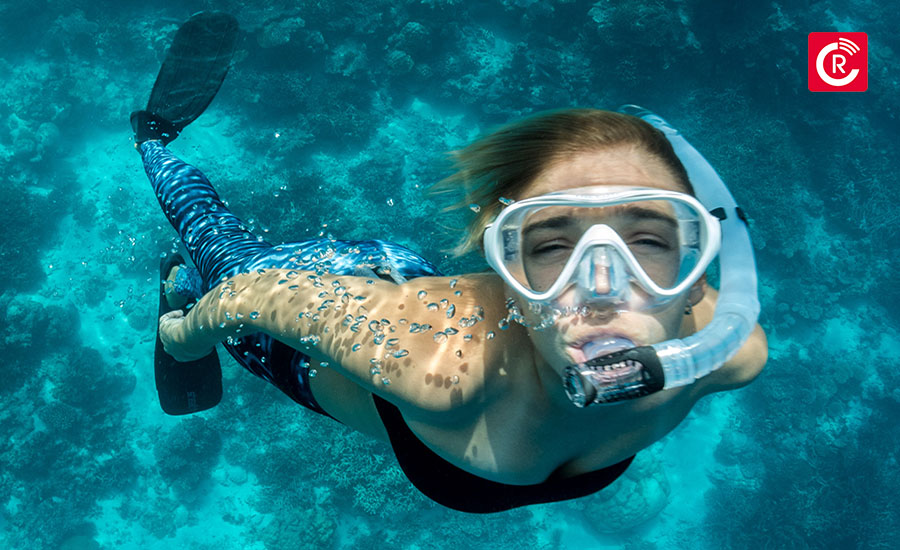
Freediving is also known as skin diving or breath-holding diving. It is a form of underwater diving that does not use any apparatus for breathing; instead, it depends upon breath-holding while underwater. Some of the freediving activities are freediving photography, underwater football, synchronized swimming, underwater rugby, etc. Now let us see what these freediving weights are. A freediving weight is a safety item for a diver that must be able to release in case of any emergency, allowing your weight to drop but at the same time lock you enough to enjoy your diving activity usually.
How Much Should Be Your Freediving Weight
It is imperative to know that the correct weight you should wear in freediving. The weight is worn to counteract the positive buoyancy of the diver’s body and their wet suits. If you want to free dive comfortably, you must use a proper weight to achieve buoyancy. If you are overweight, then it will cause several problems. First, you will find it hard to rest on the surface and breathe properly before diving. There are chances of sinking also, and if you have a trainer to assist you, being overweight will make it harder for your trainer to help you.
Second, being heavy means making the most lethal part of your free dive more difficult. While at the depth, your GI tract, lungs, and wetsuit are all compressed, making you even more negatively buoyant. So at the most hypoxic point in the breath-hold, you will have to work harder to get your breath if you are overweight, which is not a good situation.
Our body composition is unique. The factors affecting buoyancy include your bone density, muscle density, lung volume, height, weight, etc. These factors and the water density also affect buoyancy; for example, salty water makes you more buoyant than freshwater. If you want to know how much weight is ideal for freediving, you must try the trial and error method. Start with a small weight, and then you can borrow additional weight to decide how much you require.
Get into the water and flood your wet suit, ensuring that no air bubbles get trapped inside. Now position your head upright and take the maximum breath that you would take if making a dive.
The goal is that you must float up around your collarbone level, and if water is higher than your collarbone, then eliminate some wait and if it is below, add some and same way, make the necessary changes and try again. You can try using new types of equipment and in different bodies of water. You must be able to keep yourself safe in shallow water and achieve neutral buoyancy and rest easily on the surface between dives.
The correct weighting will change depending on the environment also. And it is essential to learn the proper weighting for free diving. Some of the factors that affect the weighting system were mentioned earlier. It also includes the thickness of your suit, the water’s temperature, and the nature of the water bodies, which all need careful attention. As mentioned earlier, the most important thing for your safety is achieving buoyancy while on the surface. It is possible only when you apply the correct weight.
The most popular system of proper weighting is neck weights and rubber weight belts. And among these, the most popular choice is the rubber weight belt. The rubber weight belt tightly fits your hips, and small weights are evenly positioned around the whole body.
And if you are an experienced freediver, then you can go for neck weight also. And the most important thing that you must look at while choosing your weight is how quickly you or your assistant can remove it if stuck in an emergency.
How To Find The Best Choice of Freediving Weight Method
If you are a beginner or new freediver, you must buy the best freediving weight belt. Otherwise, a wrong choice will limit your abilities as a freediver. You will not have a comfortable freediving experience because it will interfere with your speed and agility while underwater; not only that, it can cause an emergency case too. If you are serious about freediving, then you must invest in the proper place. Try buying a rubber weight belt because rubber is an ideal material as it can stretch with your diaphragm as you breathe.
If you purchase any other type of weight belt, it can hinder your airway and cause trouble in maximum inhalation and exhalation. Therefore, there are more benefits in investing in a freediving rubber weight belt. Before that, let us see what the purpose of a freediving weight belt is.
If a diver wishes to achieve neutral buoyancy, he must add weights. It is because the freediving suits are of neoprene, filled with air bubbles. That means they are naturally buoyant, and if you want to fight against the positive buoyancy, you must add weights. And we have discussed earlier the popular weight methods. Now we will see some of the advantages of the most popular weight choice: a rubber weight belt.
Few Points About Rubber Weight Belt
The weight belt should be comfortable and must be able to release quickly while in an emergency. So that the emergency release will at least allow the diver to float to the surface even if unconscious, and there will be chances of rescue. The nylon weight belts are durable and affordable, but it doesn’t stretch. While a rubber belt stretches easily with your breath and your movement. So why limit your freediving potential with a nylon weight belt. They will make you uncomfortable, and your dives will be much shorter. So it is better to avoid them and opt for rubber weight belts. Few reasons for doing so are:
- The rubber weight belt will not restrict your breathing. It will allow you to have the most oxygen and dive as long as you can without any interference. It is possible only by inhaling deeply into your diaphragm, which maximizes the amount of oxygen filling your lungs. And the material of the weight belt plays a crucial role in this process. Because stiff nylon weight belt will not allow you to inhale into your diaphragm because it does not stretch fully.
On the other hand, a rubber weight belt will let you inhale maximum because it extends according to your breathing. And this reason alone is sufficient to choose a rubber weight belt over a nylon one.
- While finning, a freediver will surely want freedom of movement. And the stretching quality of a rubber white belt allows you to move with a good range of motion through the water. It will not restrict your waist and hip movements. But if you use a nylon weight belt, it will dig into your wetsuit and skin, limit your activity, and slow you down. If you want to have a wonderful freediving experience with a perfect technique, you must wear a rubber weight belt.
- While in the water, you must feel comfortable, relax and calm. If you feel uneasy, it might distract you and make it a bad experience for you. Add a weight belt plays a significant role in making you feel more comfortable. You are wearing something rigid and inelastic like nylon will make you feel restricted and uneasy. It can prove dangerous also if you start feeling anxious as deeper you dive.
In many cases, it can prove lethal, too, if it interferes with your breathing, elevates your heart rate, and you panic. So to avoid all the dangerous conditions, it is essential to feel comfortable. And you can achieve that comfort level by using a rubber weight belt.
Conclusion
The article was all about the free typing weights and their importance. You might have got an idea regarding the freediving weights and their use. You can also take the help of reviewscast.com to review products and choose the best one for you. They will provide you with the best deals on free diving weights, and their products are excellent. The primary purpose of using freediving weights is to counteract buoyancy.
And this buoyancy can be of the diver, other pieces of equipment such as diving suits, cylinders, etc. So to avoid any emergency and for a good diving experience, you must use free diving weights.





